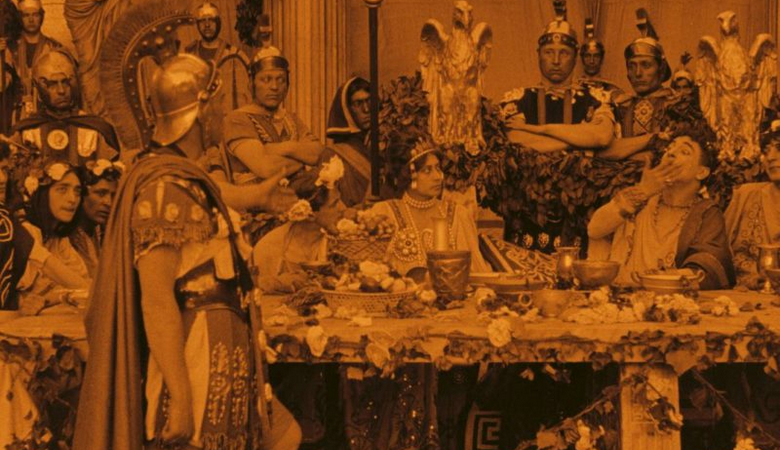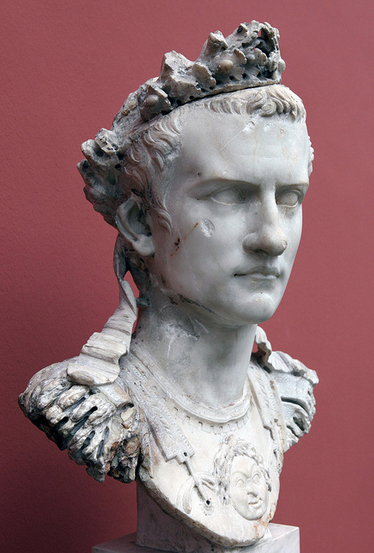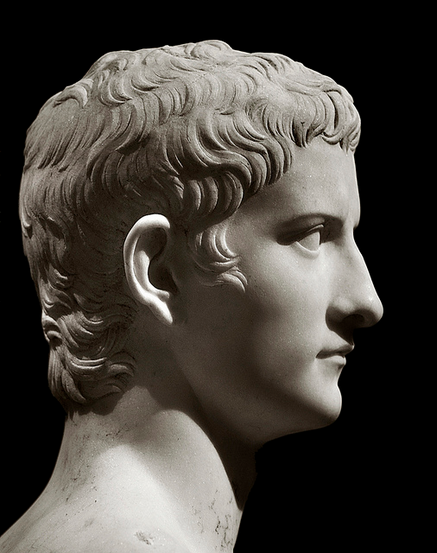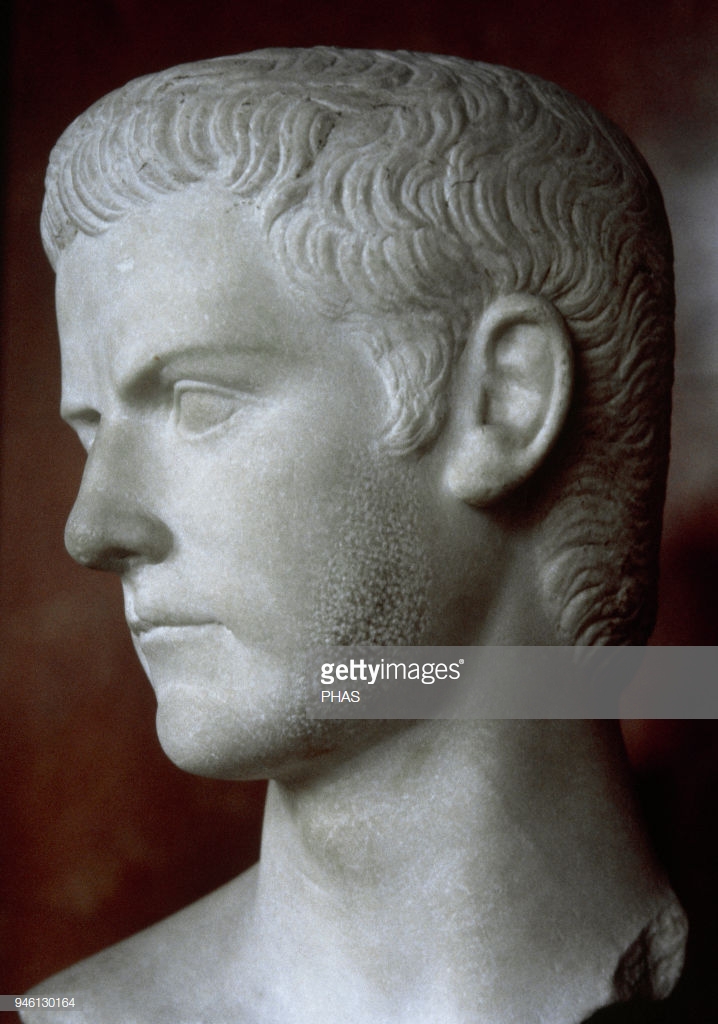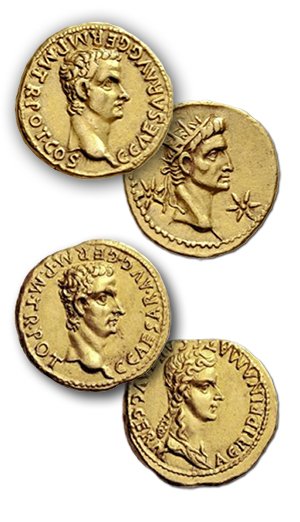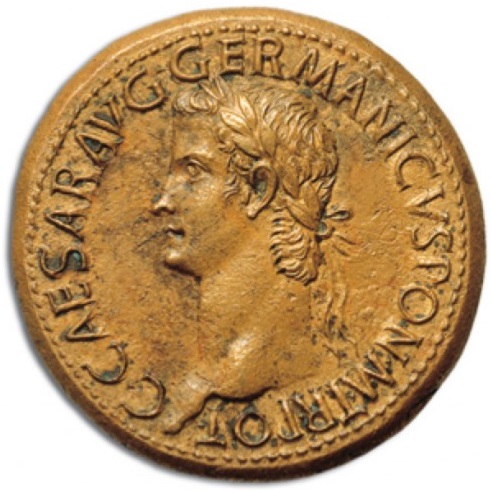Despite 35+ years of intensive research, we are still missing some important documentation and information.
If you can help with any of the below items, PLEASE CONTACT ME IMMEDIATELY!!!!!!!!
There are probably other gaps in our files that I neglected to list below. I’ll update the below list as I think of things.
•
Any information on the whereabouts of Enrico Guazzoni’s movie version of
Caligola
from 1916.
I can find no details anywhere.
•
Well my oh my oh my. Look at this. La tragica fine di Caligula Imperatore from 1917,
by Jean Carrère and Ugo Falena.
A couple of years ago, I emailed the Eye Film Museum asking if I could see this movie.
I also mentioned that there was another copy in an archive in Italy.
I’m writing this from memory.
My memory is that the response was Yes, absolutely, I could see this movie,
but only if I were to go to Amsterdam and make an appointment.
My memory is that the person who answered me expressed some interest in a possible restoration
if only I (or somebody) could coördinate with the Italian archive.
Well, so much for that.
But look what happened! And it was screened!!!! In Italy.
I cannot travel to Italy.
Even if I could afford the money, my cat told me, in no uncertain terms,
that she never wishes to travel.
And she’s going to outlive me.
So that’s the end of that.
This movie has been scanned, though.
Is
this a hint that it might come out on home video soon?
•
Any information on the whereabouts of Enrico Guazzoni’s original,
uncut silent movie version of Messalina from
1922 or 1924.
Here it is,
terribly overspeeded (to accommodate sound projection)
with the left side cropped off (to make room for the sound track), murky, and with voices added.
The result is rather ridiculous, yes?
I’d rather see the original. Does it still exist?
•
Interviews with people who knew Franco Rossellini as a child, teen, and young adult.
•
Interviews with people who knew Bob Guccione as a child, teen, and Blair Academy student. On what Italian movies did he work as a dubbing actor? Is it true that he was really a truck driver and licensed private investigator in California? Is there any truth at all to his claim to have attempted a priestly life? What was the real identity of the “Carla Ricci” mentioned in (and then blanked out from) Guccione’s undated pseudonymous solicitation letter? To whom was the solicitation letter mailed?
•
Federico Fellini’s drafts of the Messalina script from 1947.
•
Gore Vidal’s drafts of the movie version of The Left Handed Gun.
•
Silvio Amadio and Carlo Romano’s treatment and/or screenplay of Caligola: cesare e dio (1960).
•
Any information on Cinefinanziaria’s production of Caligula (1964),
to have starred Anthony Franciosa and Rex Harrison.
•
Jean Gruault’s full Caligula script from 1964.
On file at
La Bibliothèque du Cinéma François Truffaut: Archives Jean Gruault
is a manila file folder labeled “Tibère et Caligula,” dated 19 November 1963,
that contains lengthy handwritten notes about materials that should be incorporated into such a script.
Bizarrely, these notes open with a lengthy summary of Petronius Arbiter’s Satyricon,
with an emphasis on Trimalchio’s Banquet.
The following notes are divided into two sections,
“Vie, Mort et Métamorphose de Petit Soulier” and “Journal intime de Caligula.”
The primary sources, in addition to Petronius, are Roberto Rossellini’s 1962 treatment,
Tacitus, Suetonius, Lucian’s Dialogues,
Marguerite Yourcenar’s Mémoires d’Hadrien,
Albert Camus’s Caligula, Victor Duruy’s
Histoire de la Grèce ancienne (1862),
and Friedrich Engels, presumably his Origin of the Family, Private Property, and the State:
In the Light of the Researches of Lewis H. Morgan (1884).
From these 79 pages of notes, Gruault fashioned a full screenplay,
which we know was circulating in 1965 (maybe even 1964) and continued to circulate through 1970.
Then Roberto Rossellini finally rejected it and went back to basics.
He retrieved his 1962 treatment and expanded it.
As ever, Roberto would never deign to put pencil to paper.
Instead, he would call over one or more scenarists,
tell them all his ideas as they furiously scribbled notes,
and leave it to them to type up what he had said.
The result was a new Italian treatment that saw the light of day in 1971.
Pio Baldelli published Rossellini’s treatment as an appendix to his book
Roberto Rossellini, i suoi film (1936–1972) e la filmografia completa.
Dibatitti e intervista al regista. In appendice: brani critici di A. Bazin e J. Rivette
e la sceneggiatura inedita del Caligola (Rome: “La nuova sinistra,” Edizione Samonà
e Savelli, 1972). This book, by the way, was volume 39 of a series called “Saggistica.”
By the time Baldelli received the treatment, Rossellini had edited it, having deleted Scene XX.
By the time the treatment was translated into English in 1972,
much was rewritten, abridged, and scrambled, and several more scenes were dropped.
As for Gruault’s 1964 screenplay, here’s a reference from 1970,
from Variety (weekly) 257 no. 10,
Wednesday, 21 January 1970, p. 2:
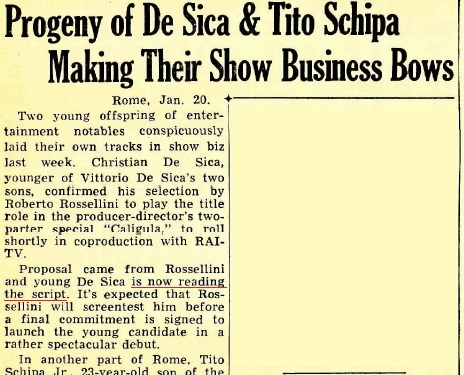
(Christian De Sica, by the way, shortly afterwards appeared in
Roberto Rossellini’s movie of Blaise Pascal.)
So if it was circulating as recently
as 1970, then there’s a chance that a copy still survives somewhere.
It is not in any archive or library that I know of.
There may still be a copy in private hands, perhaps at an agency or film studio.
•
Lina Wertmüller’s drafts of Caligula (1965–1976).
Somebody must have this script. Somebody? Yes?
Did you see this article? Claire Armitstead,
“Ninety and Out to Shock: Meet the First-Ever Oscar-Nominated Female Director,”
The Guardian, Thursday, 7 March 2019.
It mentions an unproduced Caligula that she wrote.
Was this the same as the version she was circulating in the 1960’s and 1970’s?
Or is this something new?
|
Her most recent, and probably her last, job was as
|
Oh. And here’s a book about her, by Grace Russo Bullaro,
Man in Disorder: The Cinema of Lina Wertmüller in the 1970’s
(Leicester: Troubador Publishing Ltd, 2006), p. 111:
|
Anyway, certainly
some of my films have had a great deal of success. There was even a moment
in time when they became almost a fad in America — and this pleased me a
great deal. As all the offers that Hollywood and the major companies made
me at that time pleased me. I accepted the relationship because I was eager to
make a film that I really loved, a very ironic, violent but amusing Caligula. In
the end they had other ideas and this proved to be a rude awakening for me.
|
•
Any information on Ital-Noleggio’s production of Caligula (1969).
•
Tinto Brass’s family tree.
His father’s father was the once-famous painter and art collector, Italico Brass
(b. 14 December 1870 in Gorizia, d. 16 August 1943 in Venice).
Tinto’s father, who served as vicepodestà of Venice, was Alessandro
(b. 20 January 1898, Venice; d. 1968).
Tinto’s mother was Carla, maiden name unknown, died at age 97, probably circa 1998, but I’m not sure.
Alessandro and Carla had four children, all boys:
Italico, Giovanni “Tinto,” Maurizio “Malo,” and Andrea.
Here’s Malo:
http://www.imdb.com/name/nm1198994/.
Interesting article about Tinto and his brothers:
“La guerra di Tinto per l’eredità,” La Stampa, 18 December 2008.
•
The full story of Jack H. Silverman’s moonlighting gigs as a talent agent
in the late 1960’s through the mid-1970’s.
•
Contact information for whoever controls Gianni/Roberto Tatti’s copyrights.
•
Opportunities to interview anyone intimately involved
in the business/production end of the movie version of Myra Breckinridge.
•
Opportunities to interview anyone involved in the John Calley production
of Warner Bros.’ Blue Movie (1970),
from Terry Southern’s novel, to have been directed by Mike Nichols.
•
Opportunities to interview anyone involved
in the John Calley production of Warner Bros.’ Erotikon (1972), a sexually graphic anthology by
Bergman, Fellini, and Kubrick.
Here is how Calley described it:
“At one point [after A Clockwork Orange],
Stanley, Bergman, and Fellini had agreed to do a project with me
that was specifically to be an X-rated film.
It would be a trio, like one of the old Somerset Maugham anthologies,
and it would be sexual in intent and content,
so as to establish filmmaking as on a par with other art forms.”
(“Stanley Kubrick: A Cinematic Odyssey,”
Premiere: The Movie Magazine 12 no. 12, August 1999,
pp. 84–93, 98–100, esp. p. 98.)
In that interview, Calley went on to claim that Kubrick was the first to withdraw,
excusing himself by saying that, as a devoted family man,
he was too uncomfortable with the project.
Bergman and Fellini then tendered their resignations as well.
Bergman’s episode,
“Den
förstenade prinsen,” later became a Broadway musical called
The Petrified Prince.
Fellini’s episode later became The City of Women.
Kubrick’s episode presumably later became Eyes Wide Shut.
I can’t be certain of that latter,
but he had been wanting to do Traumnovelle since 1970 if not earlier,
and he had expressed an interest in the potential power of sexually graphic imagery
at least as early as 1959.
Further, when he began to discuss the project with his preferred scenarist Frederick Raphael
he made some surprising suggestions.
Somewhat stunned, Raphael asked him if he wanted it to be hardcore,
and Kubrick responded simply, “I don’t know what I want.”
So if you put one and one and one and one together, it is reasonable to suppose
that Kubrick’s proposal for Erotikon was Traumnovelle.
•
Opportunities to interview the Yugoslav officials who were responsible
for closing down the Penthouse casino on Krk.
Any information at all on the closure would be most helpful.
•
Opportunities to interview anyone who worked with Franco Rossellini
during his brief tenure as associate producer on Pasolini’s
The Canterbury Tales.
•
Opportunities to interview anyone who worked with Franco Rossellini
during his brief tenure as associate producer on Man of La Mancha.
•
Opportunity to view the original pre-release version of A Name for Evil,
as well as the TV version.
•
Opportunities to interview anyone who worked with Franco Rossellini on
Paul Morrissey’s Long Live Sandokan (circa 1972).
•
Any information at all on the proposal for a movie on Eliogabalo.
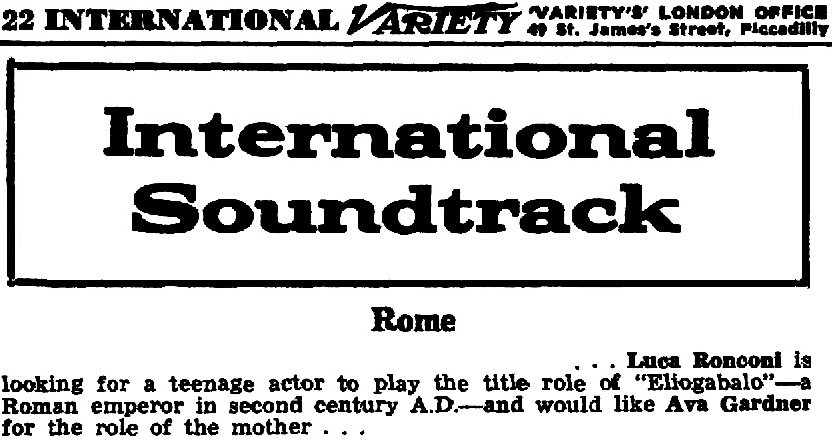
Weekly Variety 271 no. 10, Wednesday, 18 July 1973, p. 22.
•
Any information at all on Franco Rossellini’s early work on Fellini’s Amarcord.
•
Opportunity to interview Monique Van Vooren, strictly about Gore Vidal and Franco Rossellini.
•
Opportunity to interview Claire Bloom, strictly about Gore Vidal and
Gore Vidal’s Caligula.
•
Opportunity to interview Bianca Jagger, strictly about Franco Rossellini.
•
Opportunity to interview Marina Cicogna, strictly about Franco Rossellini.
•
Opportunity to interview Florinda Bolkan, strictly about Franco Rossellini
and Gore Vidal’s Caligula.
•
Any information on Franco Rossellini’s approach to Mick Jagger to portray Caligula.
•
Contract between Felix Cinematografica and La Titanus Distribuzione for the production of Caligula.
•
Signed contract with Maria Schneider for working on Gore Vidal’s Caligula.
•
Contact information for Jack Raymond, public relations consultant to Penthouse in 1975.
•
Opportunities to interview anyone who was well-acquainted with Jack H. Silverman.
•
The identity of the Italian script doctor for Gore Vidal’s Caligula.
Whoever he was (and it was definitely a he),
he was responsible for the green-cover/green-binding script falsely dated “April, 1st 1976.”
He was also responsible for the white-cover/blue-binding shooting script, dated simply “July 1976.”
•
The identity of the Penthouse staffer who gave the green script to Gore Vidal.
•
The identity of the Penthouse staffer who gave the green script to Malcolm McDowell.
•
Contract between Lina Wertmüller and Warner Bros.
•
Opportunity to interview the Yugloslav officials who denied a permit to allow
Gore Vidal’s Caligula to film in Yugoslavia.
•
Any information on a screenplay entitled The Spaghetti House Seige (1976).
There was a movie based on this true incident,
made in 1982 from a script by Age e Scarpelli
(Agenore Incrocci and Furio Scarpelli), but I don’t know if that was the same
script that was circulating in 1976.
•
Opportunity to interview L’Espresso journalist Pasquale Chessa.
•
List of extras who appeared in Gore Vidal’s Caligula.
•
Final shooting schedule of Gore Vidal’s Caligula.
Oh. Never mind. Got it.
Oh. Never mind. Got it.
•
LODGINGS.
Malcolm McDowell and his wife, Margot Ruth Bennett, were put up at the Villa Papa just off of the Via Appia Antica, in the southern outskirts of Rome.
Peter O’Toole and his manservant were put up at a different villa.
For the duration of the shoot, Franco Rossellini rented, from the Salviati family,
a villa somewhere in the vicinity of La Storta (not too far from Tinto’s house).
He held a banquet there on 2 August 1976 in honor of Peter O’Toole’s 44th birthday.
Does anybody have more details?
Exact addresses?
Exact costs of these lodgings?
Who owned the villas where Malcolm and Peter stayed?
Maybe the Salviati family?
If — and that’s a big IF —
the Villa Papa really is on or just off of the Via Appia Antica,
then my best guess is that it’s
here.
If so, then it’s invisible from the street.
Yet I doubt it is really on the Via Appia Antica.
I bet it’s at
Via Lucio Volumnio, 37.
Of course, both my guesses might be wrong.
I also learned that Bob Guccione shot a pictorial of Jane Hargrave on the grounds of Franco’s temporary villa.
In the vain hope that the photos would reveal sufficient detail that I would be able to pinpoint the property,
I asked a friend to scan me those pages from the magazine.
Nope. Darn! Should have known better.
Now, I heard, from someone who was there, that the villa that Franco rented was on the
Via Appia Nuova,
near the Circolo del Golf di Roma Acquasanta.
Impossible.
That must have been another villa that Franco was visiting on that day.
Anyway, I studied Google Maps, but I don’t see any villas nearby.
Finally, where did Ted Whitehead stay, and how long was he in Rome — what date to what date?
•
Original (or hi-def scan) of Corriere della sera, Friday, 13 August 1976.
•
Original (or hi-def scan) of La Repubblica, Wednesday, 11 January 1978.
•
The identity of the “well-known film editor”
who was flown to Rome to watch Caligula early on during the shoot.
He was mentioned, but not named, in George Armstrong’s “Caligula Unlikely to Reign for Long,” The Guardian, 12 November 1979:
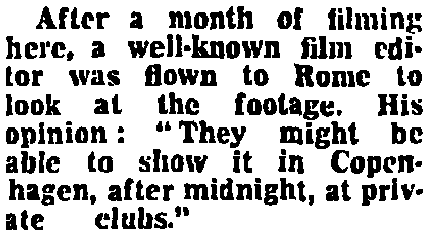
Oh. Never mind. It was not a “well-known film editor” at all.
It was Don Getz. Oy.
•
Original (or hi-def scan) of Il Tempo, Sunday, 21 November 1976.
•
Maggie Daly’s column in The Chicago Tribune (between January and early November 1977)
in which she wrote “The movie is so sexy it steams.”
Oh. Never mind.
Here it is. My guess was WAYYYYY off. 25 July 1976:
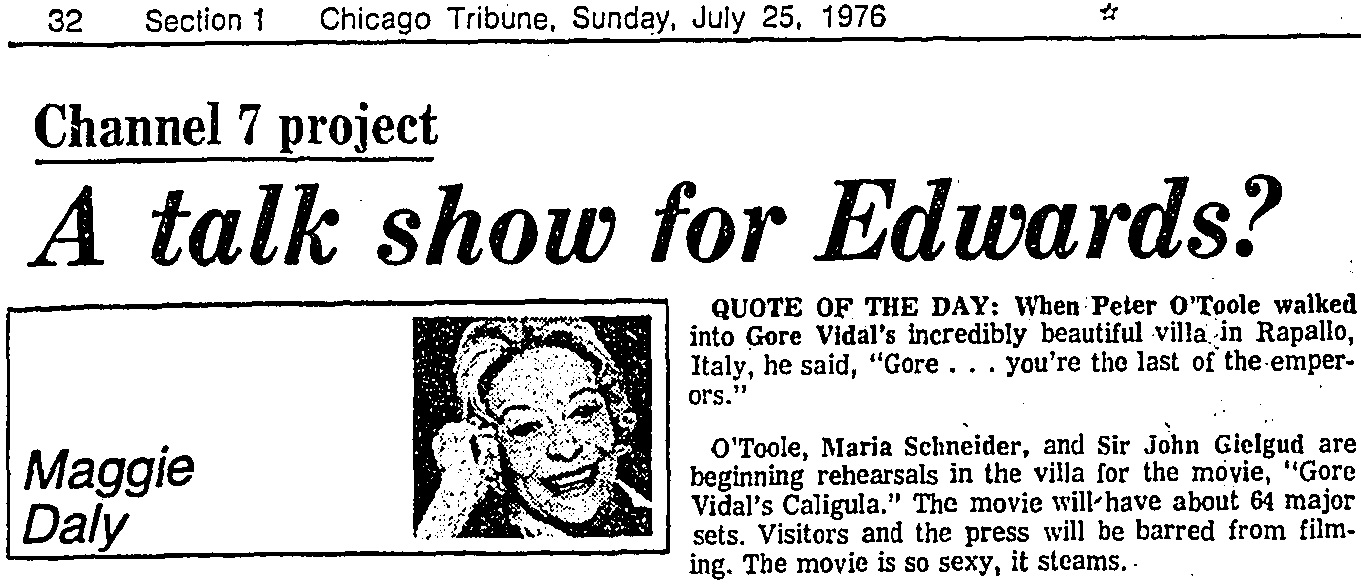
Of course, as you’ve already guessed, it was the Penthouse staffers at the publicity office who fed Maggie that line.
Shall we take a look at what other nonsense they fed her?
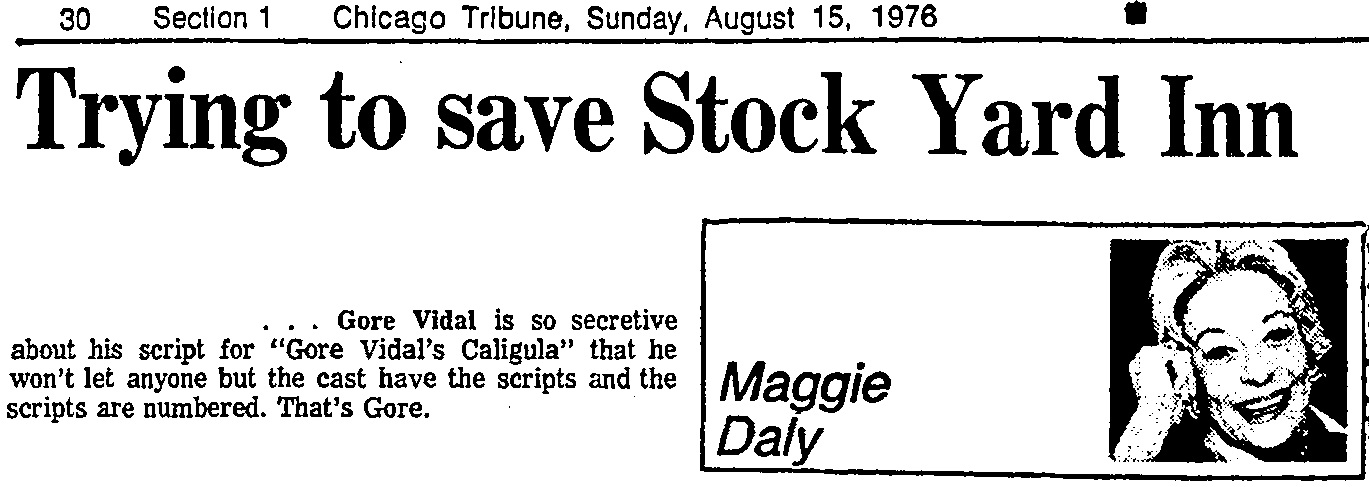
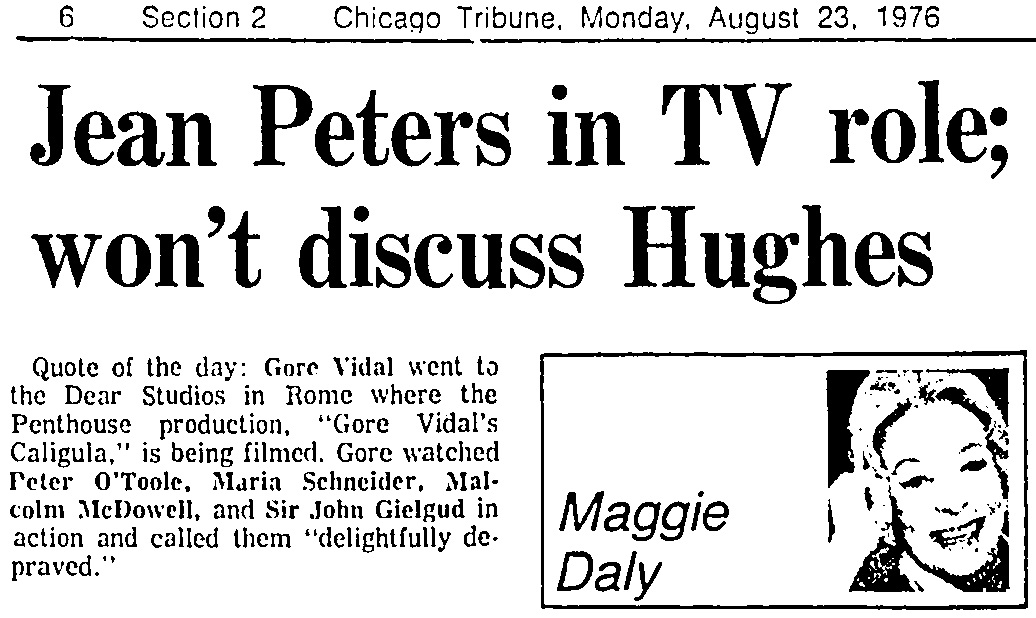
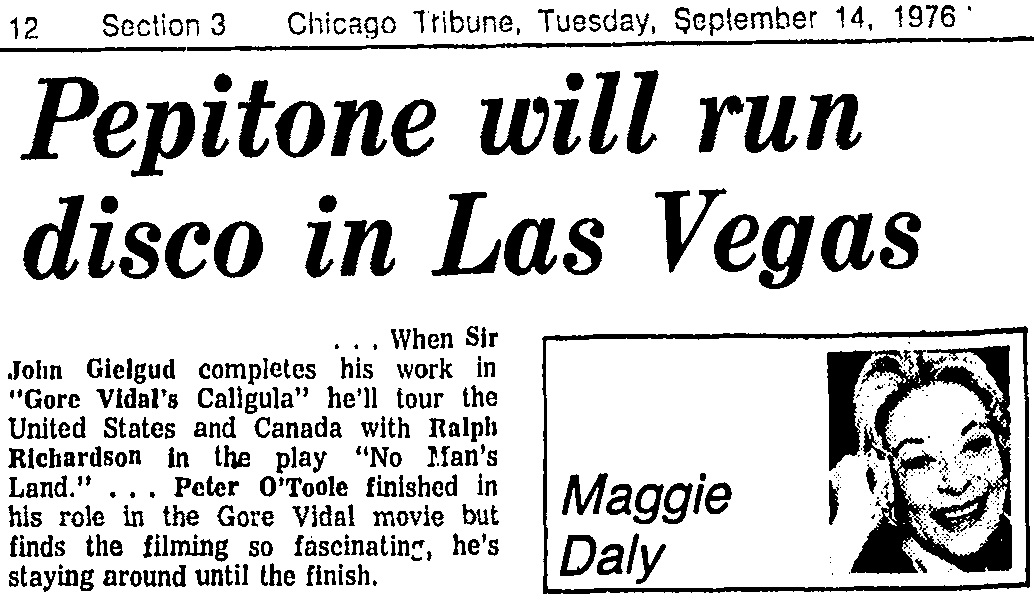
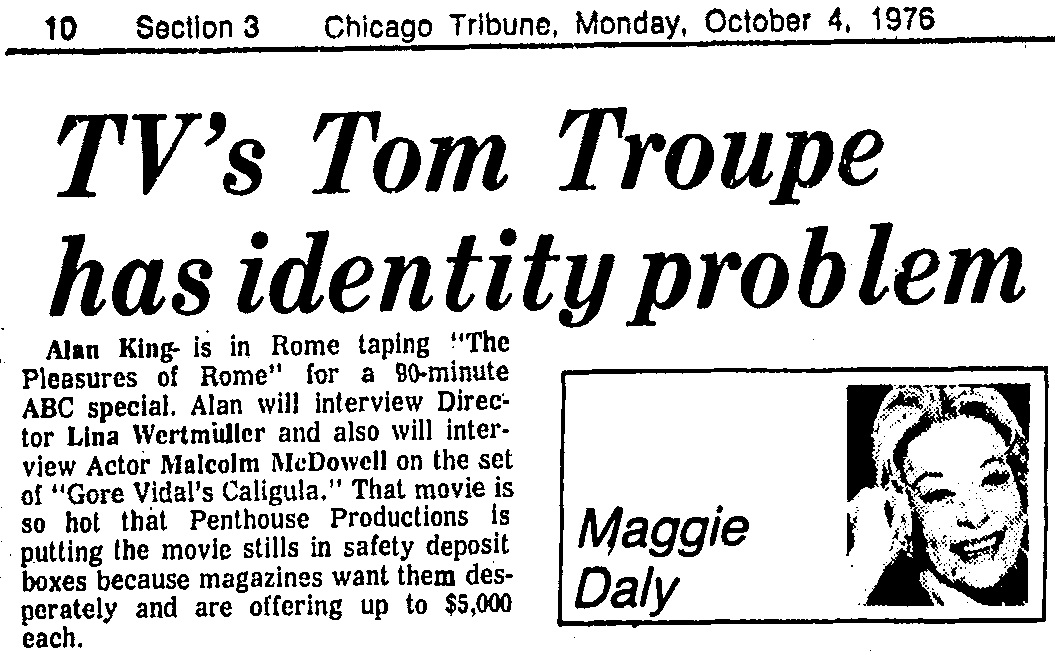
•
The source of Gore Vidal’s quote that
“There is no such thing as a pornographic movie, only pornographic audiences.”
Oh. Never mind. It’s from Women’s Wear Daily vol. 132 no. 46, 9 March 1976, p. 16. I mean, where else would you look for a Gore Vidal quote?
Oh. Never mind. It’s from Women’s Wear Daily vol. 132 no. 46, 9 March 1976, p. 16. I mean, where else would you look for a Gore Vidal quote?
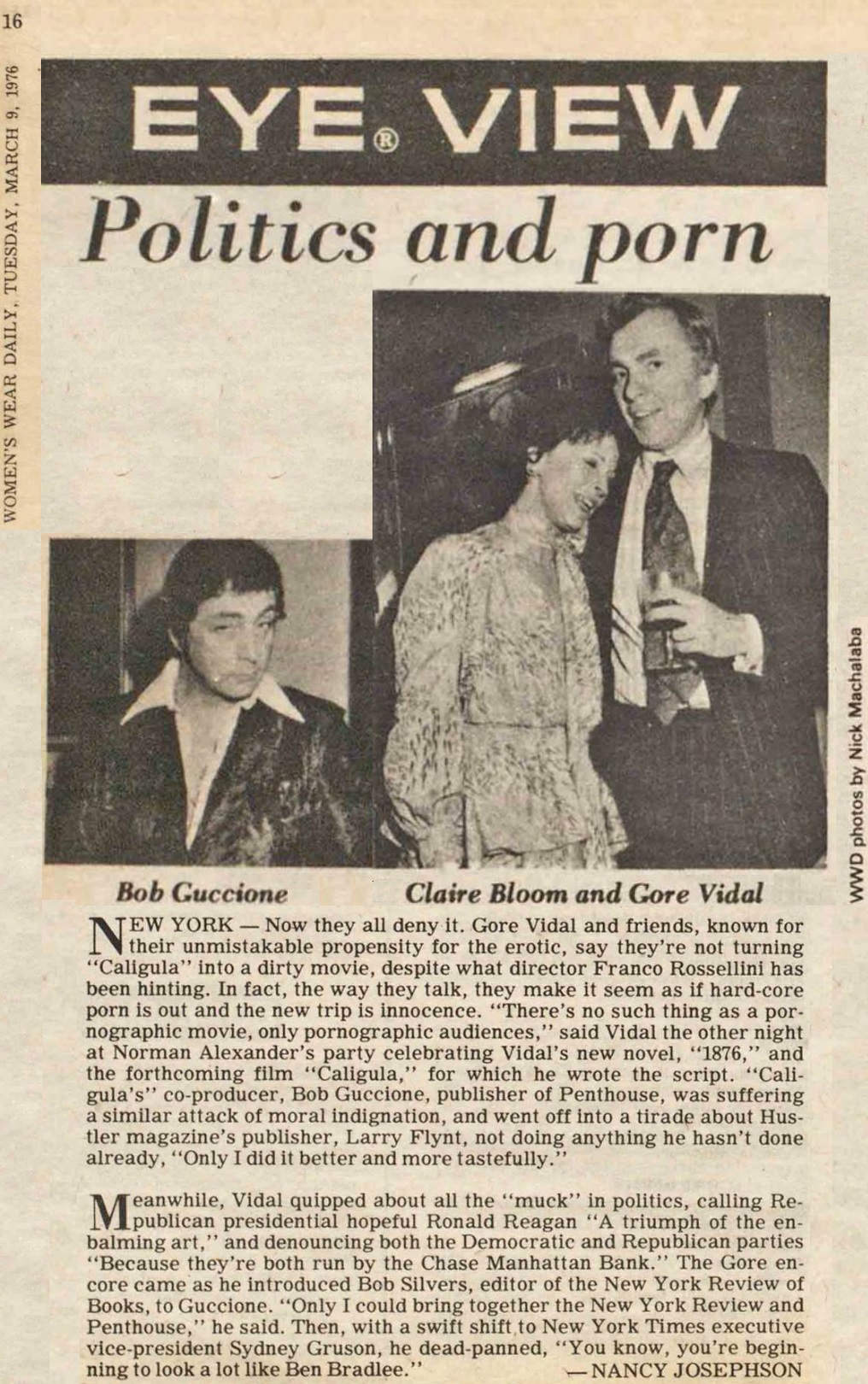
•
Insurance photos from late November 1976, as well as Tinto Brass’s letter of about the same time,
possibly related to the insurance claim.
•
Contact information for Peter J. Shaw, reporter for Penthouse in 1976.
•
Paperwork relating to Renzo Rossellini v. Eugene Luther Gore Vidal,
filed with the Corte d’Appello di Roma on or about 28 October 1978.
•
Opportunities to interview anyone who was witness to the rift between Tinto Brass and
Don Getz.
•
Speaking of
Donald Aubrey “Don” Getz
(28 March 1920 – 22 August 1993),
we need to learn everything about him we can.
He was the keeper of many secrets about Gore Vidal’s Caligula,
and he was also the brother-in-law of Peter O’Toole’s
business partner Jules Buck, which may go a long way towards explaining many things.
•
Papers submitted to the court in London (under Justice Slade and perhaps other judges as well)
in the matter of Giovanni Tinto Brass v. Penthouse and Felix, circa May 1977.
•
Papers submitted to the court in Rome in the matter of
Penthouse e Felix contro Giovanni Tinto Brass, circa May 1977.
•
Papers submitted to the court in Rome in the matter of
Giovanni Tinto Brass contro Penthouse e Felix, circa May 1977.
•
Complete finding by Judge Giovanni Giacobbe in favor of Tinto Brass, issued on 9 July 1977
(our copy is missing page 11).
•
Who made the medallion?
This medallion:
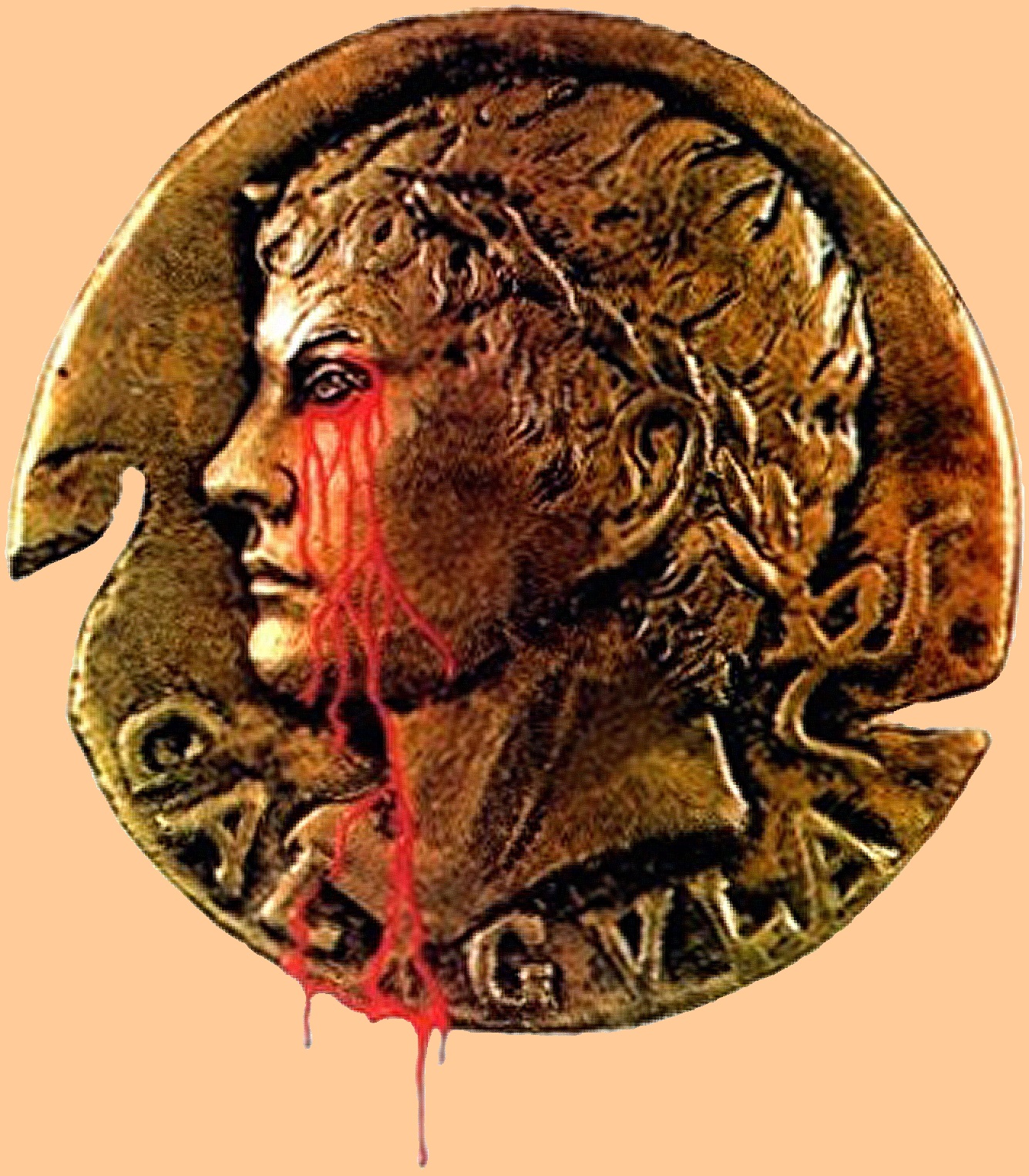
Several were minted.
Malcolm McDowell got one.
Lori Wagner got one.
And Bob Guccione kept one for himself, which for a few months he added to his mass of necklaces:
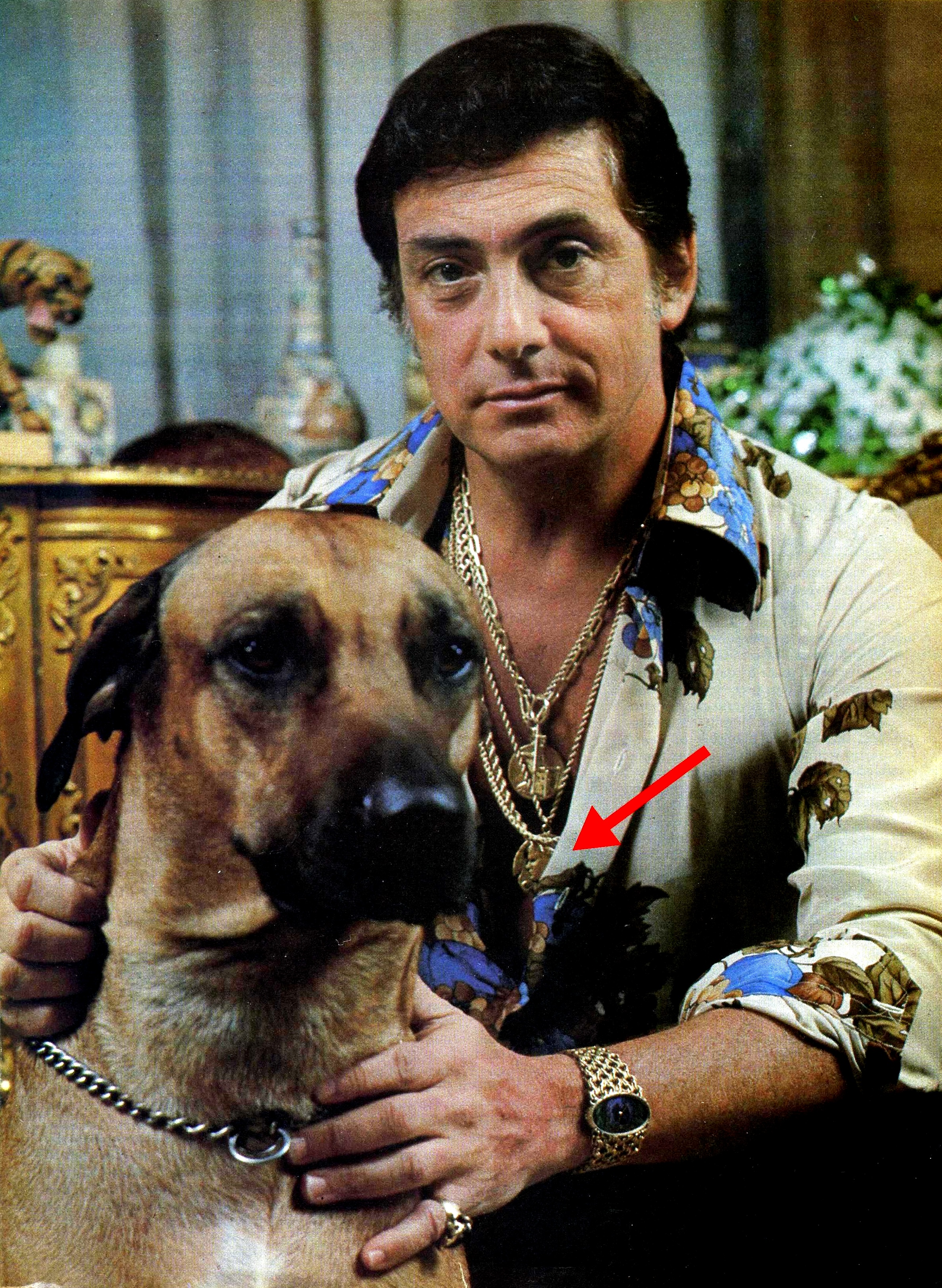
Maclean’s, 6 February 1978, p. 35.
Malcolm spoke about this necklace (Village Voice, Wednesday, 16 July 1980):
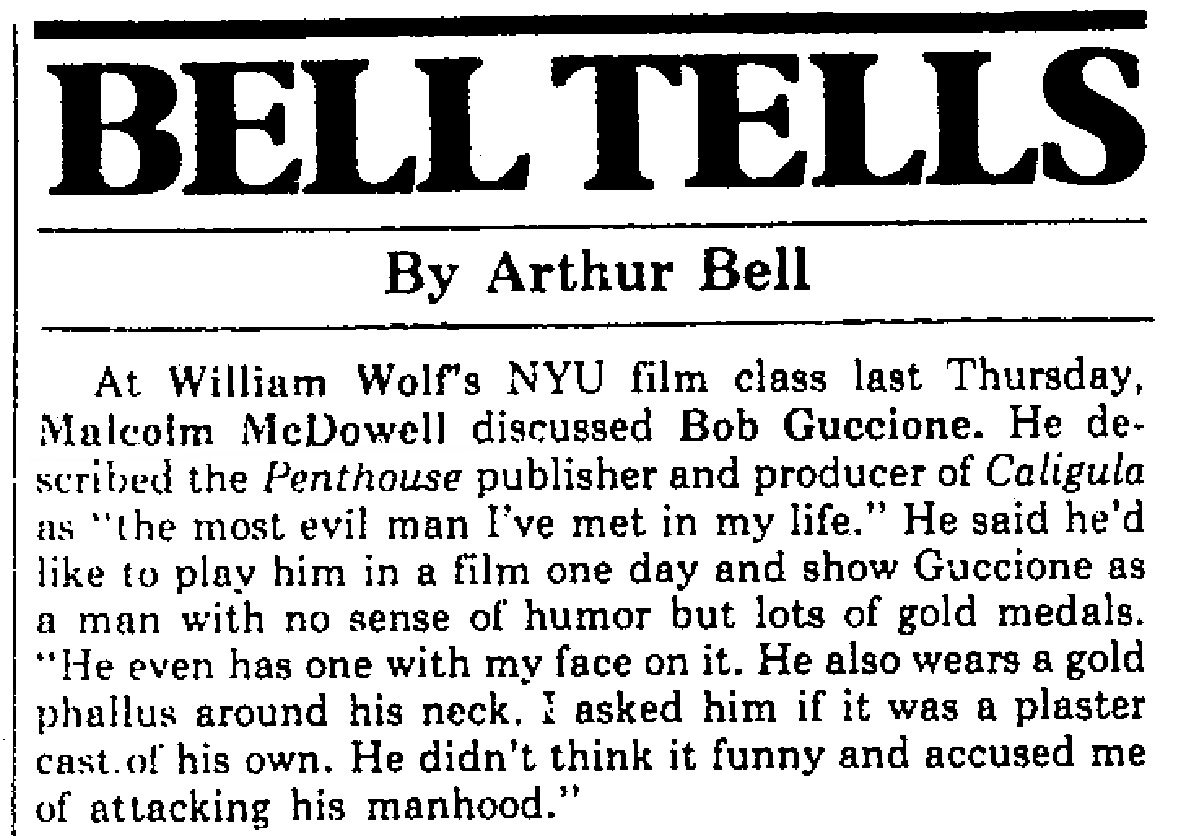
Once Bob saw Russ Lloyd’s edit of Caligula,
he ceased wearing his necklace and he ordered his people to hire a new editor.
There is a persistent claim that the medallion is not a profile of Malcolm, but of Bob.
My response: Are you guys crazy? Here’s Bob’s profile:
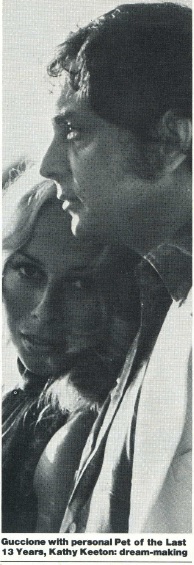
It gets crazier.
Some people say that the medallion is not modeled on Malcolm at all.
Well, what about Malcolm’s own statement above that it is his image?
Here are some images pulled off the web that show Malcolm’s profile:
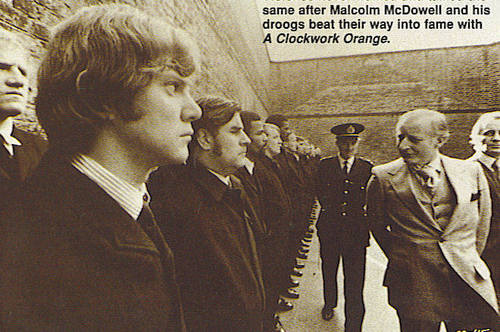
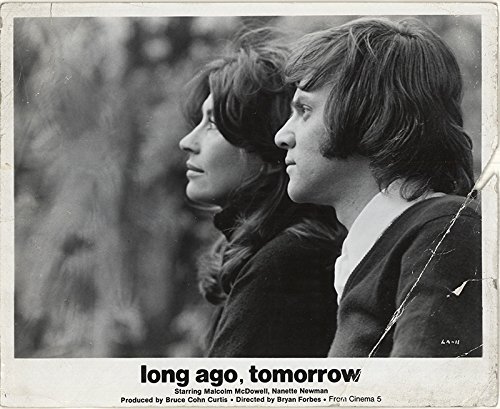 |
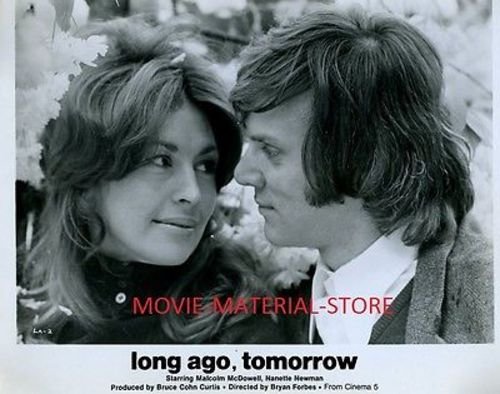
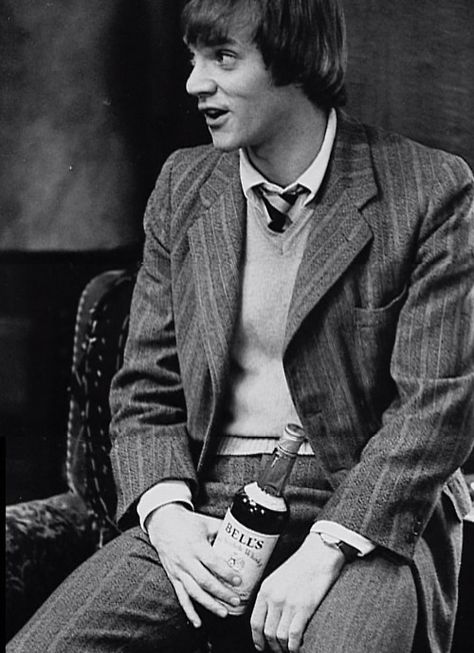 |

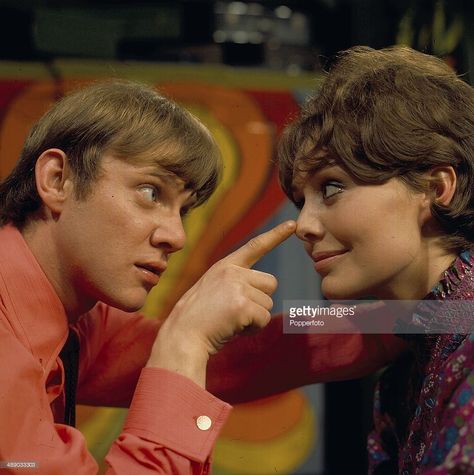
|
COMPARE: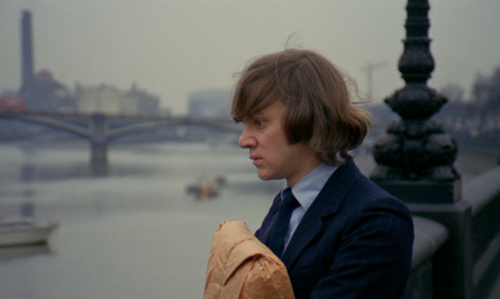

|
It gets crazier still.
There are some people who say that the medallion is actually modeled on the actual emperor.
First of all, the famous marble sculptures that are credited as being modeled on the emperor are actually modeled on a distant cousin.
No matter.
Let’s look at those marble sculptures anyway:
I suppose that after viewing the above, some people suffering from cognitize dissonance will insist that the medallion is actually based on coins. Okay:
Any questions?
Oh. Never mind. The engraver was Gary L. Erickson, 280 Mott St Apt 3FS, New York, NY 10012-3469 (outdated address, so don’t bother to knock on the door),
who had a shop in a suite somewhere at 280 Mulberry St, NYC.
Who he? Is he still around? Is he reachable? What else has he done?
Is he the same as the Gary Erickson mentioned here?
•
Okay. Now we’ve brought up Kathryn Merle Keeton and one of her numerous Rhodesian Ridgebacks,
let’s try to get to the bottom of something.
Unable to make ends meet as a ballet dancer,
she took up lucrative employment at London’s new strip clubs in the late 1950’s.
One of those strip joints was the Pigalle Club, a fancy supper club operated by Al Burnett
and patronized by Princess Margaret, Peter Sellers, Richard Burton, Audrey Hepburn, Marlene Dietrich,
Gary Cooper, the Maharaja of Baroda, Sir Pratap Singh Gaekwad,
and so on and so on and so on.
(Source: Douglas Thompson, Shadowland: How the Mafia Bet Britain in a Global Gamble,
Edinburgh & London: Mainstream Publishing, 2011, p. 129.)
This was the usual crowd for such venues.
So the Pigalle was a supper club as well as a show club as well as a strip club,
and with the Betting and Gaming Act of 29 July 1960 it became a gaming club too! [Thompson, p. 133.]
Al Burnett (1906–1973) had graduated from being boxer Kid Bones, a bootlegger,
a barbershop-quartet tenor, a TV comedy writer, and a Hollywood movie actor
to become one of the premier nightlife entrepreuneurs. His downfall was obsessive gambling.
Now Burnett, like all London nightclub owners, worked closely with boxing promoter Benny Huntman,
who had been bribing MP’s and other officials as well as police in preparation
for this new Betting and Gaming Act of 1960.
Huntman did not work alone; he was closely allied with Meyer Lansky, Frankie Carbo,
and countless other American mobsters, to say nothing of British mobsters.
Might Kathy have introduced Bob to this nightlife society?
Does this somehow tie in with The Pair of Shoes and the Penthouse Casino?
Also, was she ever in a movie or TV show with Vittorio De Sica?
Supposedly they were in an Italian movie called The Roman Interlude,
but no movie was released under that title.
In case you’re thinking that maybe the movie is Un amore a Roma, nope.
Maybe this was a reference to an episode of a TV series called The Four Just Men?
Does anybody know?
And finally, just to get it out of my system,
is Kathy the one who introduced Bob to Wolf Mankowitz?
•
Variety article that referred to Gore Vidal’s Caligula
as “the Ben-Hur of porn” (could not have been earlier than June 1976
and could not have been later than July 1977). Oh. Never mind.
Here it is:
_v287n09_p022_Pictures_'Ben-Hur'_Of_Porn.png)
For what it may be worth, according to Daily Variety vol. 156 no. 9, Friday, 16 June 1972, p. 3, col. 5,
advance publicity promised that Deep Throat would be “the ‘Ben-Hur’ of porno pix.”
Once again, Penthouse was engaging in its perennial copy-catting.
•
The identity of the author of the hardcore additions to the novelization
of Gore Vidal’s Caligula. Oh. Never mind.
The hardcore stuff was all in the original typescript.
It was not added later. Oy.
•
Piernico Solinas’s diary kept during the shooting of Caligula.
•
Interviews with anyone who saw the Gore Vidal’s Caligula
trade screenings in London in November 1978.
Salah M. Hassanein of United Artists Theatre Corp. was there,
but he’s over ninety years old and did not respond to my letter.
•
Contact information for anyone who worked on Franco Mannino’s score
for Gore Vidal’s Caligula,
or any musicians or technicians at the recording sessions.
•
Which cinema was scheduled to première Gore Vidal’s Caligula
in New York City on 1 March 1979?
•
All papers submitted to the court in Rome concerning Giovanni Tinto Brass
contro Produzioni Atlas Corsorziate, Felix e Penthouse (November 1978)
as well as Judge Giovanni Giacobbe’s ruling.
•
We have Paragroup Limited’s complaint of 29 January 1979 in the matter of Paragroup Limited
v. Franco Rossellini, Felix Cinematografica Srl, and Penthouse Clubs International Establishment
(Civil Court of the City of New York, County of New York),
but we don’t have the response or the settlement.
•
Contract between Warner Books and Futura concerning novelization of
Gore Vidal’s Caligula (circa April 1979).
•
1982 plagiarism suit,
Claude Baks v. Penthouse International Ltd et al,
United States District Court – Southern District of New York,
docket number 82 Civ. 2609 (CSH).
I can’t find this.
Because it was settled out of court,
the court kept no records.
Can anyone dig in and find this for me?
You see, to the best of my knowledge, Baks never published anything —
not an essay, not an article, not a letter to the editor, not a poem, not a piece of doggerel.
Nothing. Nada.
Except once. And that’s what staggers my imagination.
When we take a look at Tag Gallagher’s magisterial tome,
The Adventures of Roberto Rossellini,
we discover that in 1966, a year after Roberto first considered doing Caligola as a two-episode TV series,
he was comfortably ensconced with
Schlumberger (pronounced the French way: shloom-bayr-ZHAY) Ltd,
“one of the world’s ten biggest corporations.”
When Baks had first hooked up with Schlumberger, I don’t know.
The founders were Conrad and Marcel Schlumberger, of whom Gallagher writes:
The Schlumbergers were Alsacian, Protestant, pacifist, and socialist;
scientific research was their corporate priority, not profits;
they contributed heavily to socialist causes, to the civil-rights movements,
to Black and Hispanic political candidates, to almost anything challenging the status quo,
and to artists. |
These were not your typical corporate suits.
The new CEO of Schlumberger was a former French resistance fighter, Jean Riboud,
who had spent two years as a prisoner at Buchenwald.
The head of Schlumberger’s Houston office was Jean de Ménil,
who was married to Conrad’s daughter Dominique.
Let’s quote from Tag’s book again:
On April 22, 1966, Riboud and de Menil created Horizon Two Thousand,
Inc., in Houston, with themselves as directors, along with Schlumberger’s Finance
Chairman Paul A. Lepercq. This Texas charitable corporation would
funnel $500,000 to a second Schlumberger creation, Logos, S.A.R.L., in Paris
(created July 21 and “owned” by Rossellini, Jean Thuillier, and Claude Baks),
which would raise another $500,000 and produce a twelve-hour Man and His
Food: The Story of Survival in partnership with Alfredo Bini’s Arco Film in
Rome. Henri Langlois and Gian Vittorio Baldi were also involved, but Baldi
pulled out on his lawyer’s advice that “it’s not advisable to sleep in a cage
with a tiger.” Claude Baks was Schlumberger’s ombudsman, charged with
keeping alive a sort of permanent cultural revolution within the company;
he shared Riboud’s interest in film and worked with Langlois and Rossellini
on Riboud’s behalf.... |
Now, with that info hovering in the background, we should not be surprised if Baks had earlier
been involved in the Gruault/Rossellini Caligola project.
We should not be surprised to discover that he even controlled the rights,
but I have no way of knowing if that was indeed the case.
Now that we know a little bit about Baks,
it’s time to take a look at his only prose work.
It’s not what you’re expecting.
Take a look at
Patent Number 3104611 filed at the US Patent Office by a certain Claude Baks
on 25 May 1960, and issued on 24 September 1963.
This was for something called
PERFORATING APPARATUS,
which was assigned to Schlumberger Technology Corporation on 10 August 1981.
Okay then. Considering that
Claude Baks portrayed René Descartes in
Roberto Rossellini’s TV movie on
Blaise Pascal
(also featuring Christian De Sica, by the way),
we can safely draw the conclusion that he was the link
that connected Schlumberger, Rossellini, Gruault, and Caligola.
Further, Anne Caprile-Baks was also in that movie, portraying the part of
“Michèle Martin, serva di Moulinet.”
That Claude Baks would file a plagiarism suit against Penthouse for the Caligula movie
is further indication that he did indeed control the rights to the Gruault/Rossellini project.
It seems that Claude Baks and
Anne Caprile-Baks were also cofounders of a movie-production house called
Archimede International S.A.R.L., 7–11 Avenue Stephane Mallarme,
75017 Paris 17, telephone 47-66-25-86, fax 47-66-25-73,
established on 1 March 1981.
They are both still listed at Nawak, a French agency,
though there are, unusually, no further data about them posted at that site.
But there is something equally intriguing in a notice about “Archimedes Productions,”
published in Variety (weekly) 315 no. 2, Wednesday, 9 May 1984, p. 374:
“Baks, an administrator at Gaumont, packaged the new Coluche comedy,
Dagobert, about the legendary French king,
which was coproduced as a Franco-Italian affair by Gaumont, Stand’Art, FR3 and Opera Films,
Gaumont’s Italian affiliate.”
Of course, that would put Baks in the unusual situation of working as an administrator
of a company that was distributing a film in Italy
over which Baks had earlier filed a plagiarism suit.
Peter A. Coclanis wrote an interesting article,
“Wanted:
Dedicated Deep Thinkers for the Business World,”
in The Chronicle of Higher Education, 18 March 2012.
In this article he mentioned Ken Auletta’s book
The Art of Corporate Success: The Story of Schlumberger (Putnam, 1984),
and this is what he had to say:
Although I enjoyed the entire book, the main take-away for me
related to a brief section on a high-level adviser and close confidant
of Riboud’s at Schlumberger: a man named Claude Baks. Baks was
an engineer by training who began working for the company in 1946
but had no official duties. Baks had broad interests, though — film
and filmmaking, most notably — and basically served as an adviser
and transmitter of ideas to Riboud. Many of the ideas came from
Schlumberger employees who felt comfortable bouncing them off
Baks, who could attend any meeting he wanted and ask questions.
He never had a title, never had a secretary, and never wrote a letter
in his entire career at Schlumberger (he retired in September 1982).
What he did for the company, according to Riboud, was force people
to think. |
Let’s play some more.
When we Google search, we find some interesting snippet quotes.
Here’s one from
The New Yorker, 6 June 1983:
Claude Baks, of Schlumberger’s Paris office, has observed,
“Vennema was one of the few who dared to tell Riboud what he didn’t want to....
When the war ended, Schlumberger bought this company, and under Doll’s direction....
“They took over power from him,” Claude Baks recalls.... |
...D. Euan Baird, a Schlumberger executive vice-president in New York....
Claude Baks, like Euan Baird, thinks that Riboud is politically naive....
the view of Claude Baks, who was hired by Marcel Schlumberger as a field engineer in 1946,
the company lost some of its spirit when it began acquiring.... |
Oh, you think that’s enough already?
Heavens no! There’s much more!
In 1970 an oil company attempted to demolish a Parisian theatre called Vieux Colombier
to make way for a petrol station.
Claude Baks sued. And he won! You will notice a most curious statement in that article:
“Jean Rougerie continued the management
and together with the puppet artist Caprile, he tried to save the theatre”
The puppet artist Caprile? Would that be Claude’s wife Anne?
Yes indeed, it was!
You see? That’s the way it works.
You get interested in a porno flick, and you end up by studying the French resistance,
engineering, progressively minded corporate executives, and puppeteers. Never fails....
•
Contact information for anyone who saw a trade screening of Caligula
in Cannes in May 1979 or in the US in 1979–1980.
•
Documents submitted to the court in Rome in the case of Franco Rossellini
contro Federico Fellini e Gaumont-Italia (circa June 1980), along with the settlement.
•
Letter from Felix Cinematografica to Penthouse of 6 June 1980.
•
Letter from Cambital (Ufficio Italiano dei Cambi) of 17 March 1980, number 9244.
•
Letter from Cambital (Ufficio Italiano di Cambio), consent number 117602.
•
Any information on the VHS bootlegs of Caligula
circulated in the US beginning in October 1980.
•
Letter from Maurizio Lupoi to GTO (London), Constantin Film (Copenhagen),
Premiere Films (Australia/Beverly Hills), Cinelux (Swaziland), Tobis (Berlin), and other distributors,
dated 10 February 1981.
•
Final accounting of Caligola submitted by Felix Cinematografica
to the Ministero del Turismo e dello Spettacolo, circa July 1979.
•
Settlement in the case of Penthouse Clubs International Establishment
v. Felix Cinematografica Srl, filed at the court in Rome. We have the summons filed 16 April 1981
as well as the original complaint dated 2 June 1981, but nothing else.
•
Felix’s original complaint and exhibits submitted in July 1981
to the US District Court Southern District of New York, 81 Civ. 3435 – E.W.
in the case of Felix Cinematografica Srl and Franco Rossellini v. Penthouse International Ltd,
Penthouse Films International Ltd, Penthouse Clubs International Establishment, Penthouse Records Ltd,
and Robert Guccione.
•
Identities of and contact information for members of the editing crew on the
R-rated edition of Caligula.
•
Any information on Federico Fellini’s proposed film of Woman with a Hoop and Sword.
•
Any information on police seizure of Caligula
from the Showcase Cinemas Louisville (Louisville KY) on 28 April 1981.
Were you there? Drop me a message if you were.
We need all the legal paperwork and subsequent legal challenges, if any.
•
Any contracts between Franco Rossellini and producers of Caligula spin-offs
(Caligola & Messalina, Caligola: la storia mai raccontata, etc)
licensing Daniel Maffia’s logo.
•
18 July 1986 (filing), 19 January 1987 (ruling)
Tribunal de Grande Instance de Paris
Judge: UNKNOWN
Felix Cinematografica Srl contre Penthouse International Ltd et Penthouse Films International Ltd
Attorney for Plaintiff: Jacques-Georges Bitoun
Attorney for Defendants: Daniel Diedler (Diedler-de la Robertie Partners)
Tribunal de Grande Instance de Paris
Judge: UNKNOWN
Felix Cinematografica Srl contre Penthouse International Ltd et Penthouse Films International Ltd
Attorney for Plaintiff: Jacques-Georges Bitoun
Attorney for Defendants: Daniel Diedler (Diedler-de la Robertie Partners)
•
Supreme Court of the State of New York, County of New York: Felix Cinematografica Srl and Franco Rossellini
v. Penthouse International Ltd, Penthouse Films International Ltd, Penthouse Records Ltd,
Penthouse Clubs International Establishment, and Robert Guccione, 671 F. Supp. 313, 315 (SDNY 1987).
We have Felix’s complaint filed on 17 July 1986 and Penthouse’s responses
dated 20 and 21 October 1986, but then the record goes blank.
•
United States District Court Southern District of New York: Felix Cinematografica Srl and Franco Rossellini
v. Penthouse International Ltd, Penthouse Films International Ltd, Penthouse Records Ltd,
Penthouse Clubs International Establishment, and Robert Guccione, 83 Civ. 6183 (WCC) (USDC 1987).
We are missing defense’s Exhibit Book submitted with the 20–21 October 1986 response.
•
23 February 1987 (filing)
Tribunal de Grande Instance de Paris
Penthouse International Ltd et Penthouse Films International Ltd contre Felix Cinematografica Srl
Judge: UNKNOWN
Attorney for Plaintiff: Daniel Diedler (Diedler-de la Robertie Partners)
Attorney for Defendants: Jacques-Georges Bitoun
Tribunal de Grande Instance de Paris
Penthouse International Ltd et Penthouse Films International Ltd contre Felix Cinematografica Srl
Judge: UNKNOWN
Attorney for Plaintiff: Daniel Diedler (Diedler-de la Robertie Partners)
Attorney for Defendants: Jacques-Georges Bitoun
•
6 April 1987 (ruling)
Tribunal de Commerce de Paris, 153128, Requête afin de saisie conservatoire
Felix Cinematografica Srl contre Penthouse International Ltd et Penthouse Films International Ltd
Judge: UNKNOWN
Attorney for Plaintiff: Jacques-Georges Bitoun
Attorney for Defendants: Daniel Diedler (Diedler-de la Robertie Partners)
Tribunal de Commerce de Paris, 153128, Requête afin de saisie conservatoire
Felix Cinematografica Srl contre Penthouse International Ltd et Penthouse Films International Ltd
Judge: UNKNOWN
Attorney for Plaintiff: Jacques-Georges Bitoun
Attorney for Defendants: Daniel Diedler (Diedler-de la Robertie Partners)
•
17 December 1987 ruling of the Sezioni Unite of the Suprema Corte di Cassazione in Rome,
published on 1 March 1988, in the matter of Felix Cinematografica Srl v.
Penthouse Films International Ltd, Penthouse Clubs International Establishment,
Penthouse International Ltd, Penthouse Records Ltd, and Cosmopolitan Cinematografica Srl.
•
13 January 1988 (ruling)
Tribunal de Commerce de Paris, Audience Speciale de la Troisième Chambre, 43A, 15.09.1987 15, 25340
Felix Cinematografica Srl contre Penthouse International Ltd, Penthouse Films International Ltd, et AMLF
Attorney for Plaintiff: Ortolland (on behalf of Jacques-Georges Bitoun)
Attorney for Defendants: Daniel Diedler (Diedler-de la Robertie Partners)
Tribunal de Commerce de Paris, Audience Speciale de la Troisième Chambre, 43A, 15.09.1987 15, 25340
Felix Cinematografica Srl contre Penthouse International Ltd, Penthouse Films International Ltd, et AMLF
Attorney for Plaintiff: Ortolland (on behalf of Jacques-Georges Bitoun)
Attorney for Defendants: Daniel Diedler (Diedler-de la Robertie Partners)
•
February 1988 (filing), 13 July 1989 (ruling)
Cour d’Appel de Paris
Penthouse International Ltd et Penthouse Films International Ltd contre Felix Cinematografica Srl
Attorney for Plaintiff: Daniel Diedler (Diedler-de la Robertie Partners)
Attorney for Defendants: UNKNOWN
Cour d’Appel de Paris
Penthouse International Ltd et Penthouse Films International Ltd contre Felix Cinematografica Srl
Attorney for Plaintiff: Daniel Diedler (Diedler-de la Robertie Partners)
Attorney for Defendants: UNKNOWN
•
July 1989 (filing), 27 September 1989 (ruling)
Tribunal de Commerce de Paris
Penthouse International Ltd et Penthouse Films International Ltd contre Felix Cinematografica Srl
Attorney for Plaintiff: Daniel Diedler (Diedler-de la Robertie Partners)
Attorney for Defendants: UNKNOWN
Tribunal de Commerce de Paris
Penthouse International Ltd et Penthouse Films International Ltd contre Felix Cinematografica Srl
Attorney for Plaintiff: Daniel Diedler (Diedler-de la Robertie Partners)
Attorney for Defendants: UNKNOWN
•
5 April 1990 (filing)
Cour d’Appel de Paris
Felix Cinematografica Srl contre Penthouse International Ltd et Penthouse Films International Ltd
Judge: UNKNOWN
Attorney for Plaintiff: Maître Chantal Bodin-Casalis
Attorney for Defendants: Maître Sévellec
Cour d’Appel de Paris
Felix Cinematografica Srl contre Penthouse International Ltd et Penthouse Films International Ltd
Judge: UNKNOWN
Attorney for Plaintiff: Maître Chantal Bodin-Casalis
Attorney for Defendants: Maître Sévellec
•
June 1990 (filing), 16 November 1990 (hearing)
La Cour de Cassation
Penthouse International Ltd et Penthouse Films International Ltd contre Felix Cinematografica Srl
Docket Number 90000065
Judge: UNKNOWN
Attorney for Plaintiff: Daniel Diedler (Diedler-de la Robertie Partners) and Maître Fanet
Attorney for Defendants: Maître Chantal Bodin-Casalis, for Maître Jacques-Georges Bitoun
La Cour de Cassation
Penthouse International Ltd et Penthouse Films International Ltd contre Felix Cinematografica Srl
Docket Number 90000065
Judge: UNKNOWN
Attorney for Plaintiff: Daniel Diedler (Diedler-de la Robertie Partners) and Maître Fanet
Attorney for Defendants: Maître Chantal Bodin-Casalis, for Maître Jacques-Georges Bitoun
•
And I shouldn’t close without making a mention of this.
It is an advertisement that Penthouse magazine accepted and ran in several issues in 1980
and possibly in other years too:

If this had appeared only once, I could well imagine that it was an oversight.
A camera-ready advertisement arrived along with a check,
and the staff hurriedly pasted it into the mechanical.
Okay. We all make dumb mistakes.
It is easy to see how this could have gotten into the pages unnoticed
when staff were under the gun to meet a printing deadline.
But this advertisement appeared at least three times: May, June, and December 1980.
What does that tell us?
What were the ingredients in those “Spurious Knockout Pills”?
How many people ended up in the emergency room because of those pills?
How many ended up at the morgue?
Or in a ditch or in a dumpster?
Note the deliberate misuse of language: “specious” and “spurious,”
attempts to have it both ways should this ever end up in court.
But how could it end up in court?
“Creams & Things” and “21st Century Labs” were obviously DBA’s.
The mailing address? It was a forwarding agency, and an anonymous one at that.
Anyone who has more information about this ad, the entity that used these DBA’s,
the pills, the ingredients, the consequences, and the names of any victims is more than welcome
to write to me.
